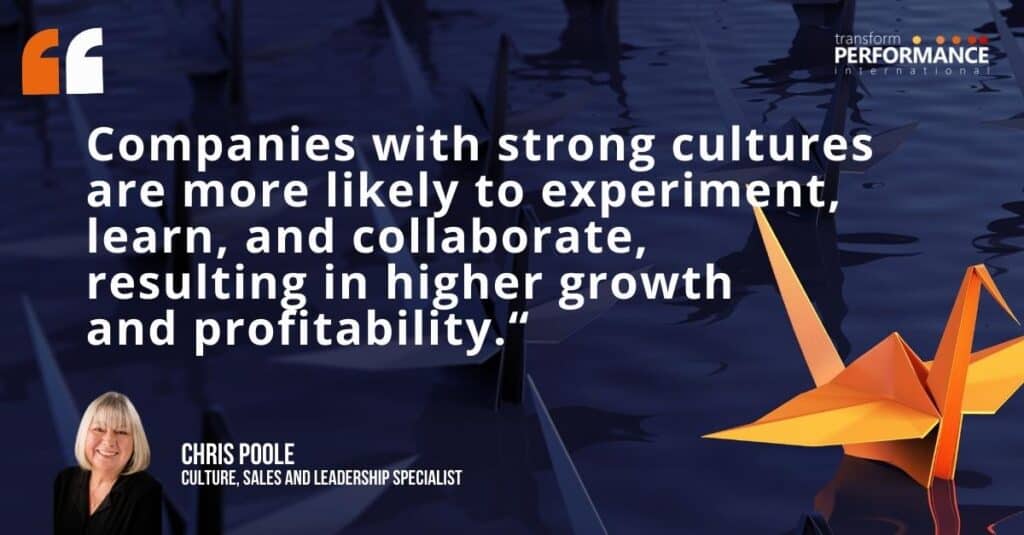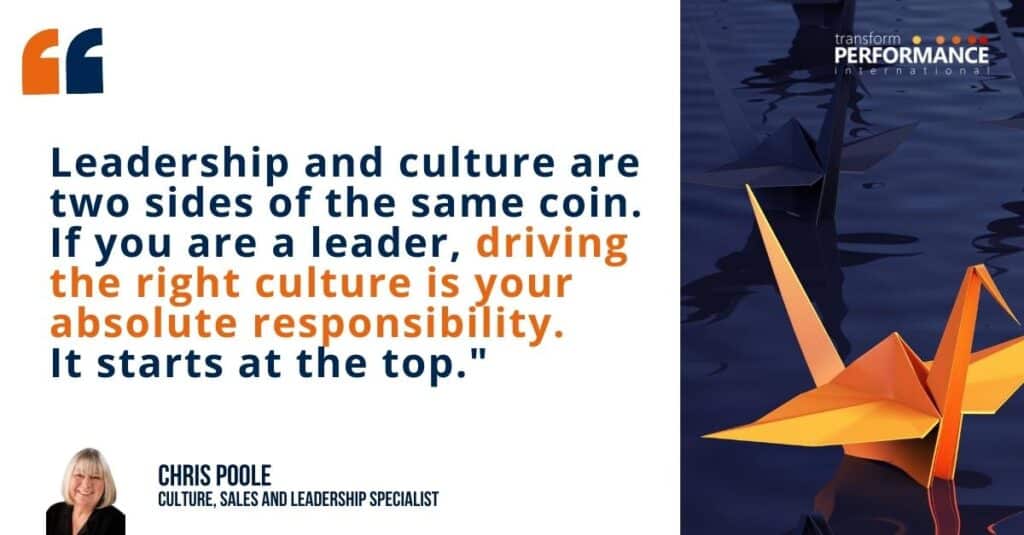Investing in culture can feel expensive and daunting. But the cost of a bad culture? Loss of talent, loss of morale, and loss of revenue. Chris Poole – culture, sales and leadership specialist – dives deep into the practical steps you can take to build a thriving company culture for us in this guest blog.

I’m often struck by the approach businesses, aka their leaders, take to culture. It feels as though it’s something that really, genuinely matters to them and yet it commonly ends up being compromised by budget realities, or it’s in the ‘too difficult’ box.
Either way, grand plans and big promises remain undelivered, leading to frustration and a lack of engagement throughout the business.
I’ve worked my way through various organisations throughout my career so far and have thrived within an organisation that’s genuinely committed to a people-first culture. I’ve also coached leaders who wanted to achieve such a people-first culture in their own organisations. I’m therefore eager to share some insights gained along the way.
The elephant in the room: overcoming the fear of emotion in the workplace
Firstly, let’s do something that’s very important to me: tackle the elephant in the room. Emotion.
Often, investing in culture is seen as a ‘nice to have’. People wonder why they need to worry about the fluffy side of business. There’s a tangible fear of emotion in the workplace and I have a theory that this is something that often stands in the way, sometimes blocking the greatest leaders from taking on the challenge of improving their culture.
From “nice to have” to the bottom line: why culture needs investment
As it’s clear that profit and shareholder returns will always be a key indicator for business success, it might be worth reading on with these statistics in the back of your mind:
- According to Gallup, a culture that attracts high-performing talent can lead to 33% higher revenue;
- A study by Bain & Company found that companies with strong cultures had customer loyalty rates that were 2.5 times higher than those of their competitors;
- A McKinsey & Co report revealed that companies with strong cultures were more likely to experiment, learn, and collaborate, resulting in higher growth and profitability.
Building a sustainable culture change programme: step-by-step guide
Like any business problem, the pain of a poor or negative culture needs to become enough of a problem for proactive action to be taken. I genuinely believe that most CEOs do care about the culture of their business but the reality of changing it can be daunting (and potentially expensive).
Too often, therefore, we might see businesses ‘tickle around the edges’ of their culture and then wonder why there’s no obvious change to the big picture. Without long term commitment and an achievable plan, tackling cultural transformation often falls at the first hurdle.
For me, there are certain steps that are essential in any culture change programme if it’s going to work and deliver the desired long-term results.
1) Take a sustainable approach, because culture change is a marathon, not a sprint
Depending on the size and complexity of the organisation, it can take a considerable period to implement an effective and meaningful change to the culture. This is because it involves human behaviour change which isn’t a quick fix. One way to counteract this potential negative to starting a culture change programme is to see it as a continuous process of improvement and not a one-off event. It’s not something you achieve or fail, but instead a journey of steering in the right direction and a continuous effort.
2) Leaders are the cornerstone of a strong culture
It’s common for leaders to share aspirations about culture; most are knowledgeable and passionate and know what good looks like. But if their behaviours don’t reflect the picture they paint, or actions don’t align with words, people will immediately lose trust.
Say it with me: “Leadership actions speak louder than culture aspirations”.
I see leadership and culture as two sides of the same coin. If you are a leader, driving the right culture is your absolute responsibility. It starts at the top.
Those who drive and enable excellent cultures, reap the rewards.
3) Quantify the impact of culture on your bottom line
When it comes to building the business plan for investment in culture, it’s understandable that leaders need to demonstrate tangible value to satisfy the inevitable return on investment question.
This can be tricky when measuring projects involving people but that’s why careful consideration needs to be given to what success and value look like. This can be done by linking the capabilities you want people to display, the productivity rates you’d like to see, and then you are starting to bring culture and business success closer together.
In other words, by connecting desired capabilities, targeted productivity rates, and aligning these with organisational culture, leaders can effectively bridge the gap between culture and business success.
4) Lead with integrity: ethical leadership drives employee trust and culture change
In a strong culture, leaders communicate their vision authentically and with simplicity. They convey gratitude and appreciation; reward innovation and collaboration; include people in their decision-making.
However, an important aspect of a strong culture which I feel is often overlooked is integrity. By this I mean consistency of behaviour.
The more a leader believes in the culture they want to achieve, the more consistently they will model the behaviours they want to see and the more this will then percolate down through their senior team and into the wider organisation.
Choosing to abandon high standards when the going gets tough is the fastest way to cause people to question your integrity, lose trust in you and stop believing that the business is the right one for them.
Belief is contagious. The stronger the belief in creating a strong and positive culture is at CEO and C-Suite levels, the more people will trust that it’s genuine and feel safe in also working towards what they see being modelled.

Culture must be prioritised and championed by leaders
Ultimately there is a huge amount that a leader can do to influence not just the culture itself but where it sits on the list of business priorities.
However, it requires a deep commitment, total belief in the value it can bring, and the need to potentially be vulnerable, all of which can test the mettle of the strongest CEOs.
A challenging economy will always create a need for prioritising investments and traditionally, the people-focused initiatives lose out. But a visionary leader who sees past the initial outlay and believes in the profound and long-lasting benefits a good culture can bring will find the outcomes far outweigh the investment.
As well as the economy, staffing is a huge challenge for many businesses and recruiting and retaining talent is at the peak of this issue.
Good people stay where cultures are strong. They do not stay where they feel undervalued.
We know that in today’s job market, candidates are highly selective about the companies they choose to work for, with the quality of organisational culture having become a crucial factor. People are no longer afraid to leave their employment if it makes them unhappy.
How to get your culture change programme off to the right start
In summary, the topic of culture is as wide and varied as the range of different organisations out there. One thing that is certain, though, is that the impact of doing nothing is likely to be the loss of talented high performers, together with low morale in the remaining workforce and the impact on your customers and revenue.
Here are a few insights that I believe will get a culture change programme off to the right start:
- A long-term view
- One of the best cultures I’ve ever worked within was a business which invested in an initial year-long programme (with Transform Performance, so it was my first experience of this organisation too) which started at the very basics of the behaviours we saw as essential across the sales and service organisation then building the programme based on assessment and coaching, addressing the gaps we discovered.
- Leverage external assessment
- It’s often hard to see the wood for the trees when you try to objectively assess your own organisation. Independent testing and analysis can help to bring any potential issues to light. Transform Performance use several different tools to help businesses understand the unique qualities of people, enabling development of both strengths and weaknesses.
- Reinforcement
- Cement the investment you are making in your people with coaching or mentoring rather than simply sheep-dipping people through a training programme. Coaching can be 1-2-1 or 1-2-many but it will always enable more quality learning and personal reflection than a generic training course or workshop.
A strong and positive culture is essential for fostering a healthy work environment, attracting and retaining top talent, promoting innovation, and ensuring the long-term success and sustainability of your business.
I hope you have found this helpful!
Thank you to Chris for this insightful piece for Transform Performance. You might also be interested in this piece on actionable tips on how to communicate change, how to handle objections, and the importance of training leaders to communicate effectively.
Are you launching a culture change programme? If you need help building a culture that drives results, get in touch. You can reach us via the contact page or call +44 (0) 1488 658686.





